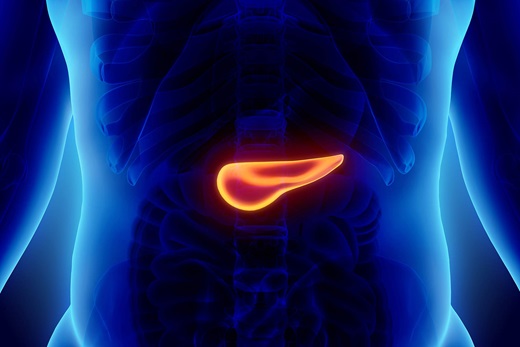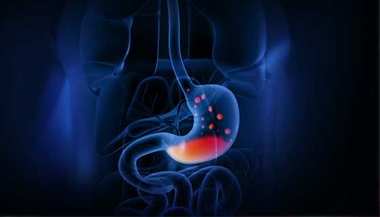Pancreas Scan
What is a pancreas scan?
A pancreas scan is a radiology test used to check the pancreas for a certain type of tumor. A pancreas scan is a type of nuclear radiology test. This means that a tiny amount of a radioactive substance is used to help check the pancreas. A pancreas scan may also be used to treat certain cancerous tumors of the pancreas.
In many nuclear medicine tests, the radioactive substance is called a radionuclide. But the radioactive substance used in a pancreas scan is called a radiopeptide. This is because the compound to which the radioactive material is attached is a synthetic peptide (an organic compound which is a component of protein). Because tumor cells easily bind with certain peptides, nuclear medicine radiologists have developed highly specific radiopeptides that bind with tumor cells. This makes certain tumors easier to see with nuclear imaging methods. Radiopeptides may also be used to treat certain types of tumors. This is done by using certain therapeutic radioactive substances attached to the radiopeptide.
Once the radiopeptide has bonded with the peptide receptor cells of tumors, the radiopeptide sends out a type of radiation called gamma radiation. The gamma radiation is detected by a scanner. The scanner uses this information to make an image of the tumor.
Other related tests that may be used to diagnose pancreas problems include:
-
Belly (abdominal) X-rays
-
CT scan of the abdomen or pancreas
-
ERCP (endoscopic retrograde cholangiopancreatography)

Anatomy of the pancreas
The pancreas is a long, tapered organ located across the back of the abdomen, behind the stomach. The right side of the organ (called the head) is the widest part of the organ. It lies in the curve of the first section of the small intestine (the duodenum). The tapered left side extends slightly upward (called the body of the pancreas) and ends near the spleen (called the tail).
The pancreas is made up of 2 types of glands:
-
Exocrine. The exocrine gland secretes digestive enzymes. These enzymes are secreted into a network of ducts that join the main pancreatic duct. This duct runs the length of the pancreas and connects to the duodenum.
-
Endocrine. The endocrine gland, which consists of the islets of Langerhans, secretes hormones into the bloodstream.
Functions of the pancreas
The pancreas has digestive and hormonal functions:
-
The enzymes secreted by the exocrine gland in the pancreas help break down carbohydrates, fats, proteins, and acids in the duodenum. These enzymes travel down the pancreatic duct into the bile duct in an inactive form. When they enter the duodenum, they are activated. The exocrine tissue also secretes bicarbonate to neutralize stomach acid in the duodenum.
-
The hormones secreted by the endocrine gland in the pancreas are insulin and glucagon (which regulate the level of glucose in the blood), and somatostatin (which prevents the release of the other 2 hormones).
Reasons for the procedure
A pancreas scan may be done to screen for primary or metastatic cancer of the pancreas. It may also be used to assess your response to therapy for pancreatic cancer, or to check the course of the cancer.
There may be other reasons for your healthcare provider to recommend a pancreas scan.
Risks of the procedure
The amount of radioactive material injected into your vein for this test is very small and considered safe. The injection may cause some slight discomfort. Allergic reactions to the radioactive material are rare, but may occur.
For some people, having to lie still on the scanning table for the whole test may cause some discomfort or pain.
Tell your provider if you are allergic to or sensitive to medicines, contrast dyes, or latex.
Tell your provider if you are pregnant or think you may be pregnant. Also tell your provider if you are breastfeeding.
There may be other risks depending on your specific medical condition. Be sure to discuss any concerns with your provider before the test.
Certain things may interfere with the accuracy of a pancreas scan. These factors include, but are not limited to, the following:
-
Presence of a radioactive substance in your body from a previous nuclear medicine test within a certain period of time
-
Barium remaining in the GI (gastrointestinal) tract from a recent barium test
Before the procedure
-
Your healthcare provider will explain the test to you. Ask him or her any questions you have about the test.
-
You will be asked to sign a consent form that gives your permission to do the test. Read the form carefully and ask questions if something is not clear.
-
Metal objects such as rings or jewelry should be left at home or removed prior to the scan.
-
You may be asked to not eat or drink for several hours before the test. This depends on the type of scan you are having.
-
Tell your provider if you are sensitive to or allergic to any medicines, latex, tape, and anesthesia medicines (local and general).
-
Tell your provider about all the medicines you take. This includes both over-the-counter and prescription medicines. It also includes vitamins, herbs, and other supplements.
-
Tell your provider if you are pregnant or think you may be pregnant.
-
Tell your provider if you are breastfeeding.
Your healthcare provider may have other instructions for you based on your medical condition.
During the procedure
A pancreas scan may be done on an outpatient basis. This means you go home the same day. Or it may be done as part of your stay in a hospital. This may vary depending on your condition and your provider’s practices.
Generally, a pancreas scan follows this process:
-
You will be asked to remove any clothing, jewelry, or other objects that may interfere with the test.
-
If you are asked to remove clothing, you will be given a gown to wear.
-
An IV (intravenous) line will be started in the hand or arm for injection of the radiopeptide.
-
The radiopeptide will be injected into your vein. The radiopeptide will be allowed to concentrate in the pancreas tissue.
-
You will be asked to lie still on a scanning table, as any movement may affect the quality of the scan.
-
The scanner will be placed over your belly to detect the gamma rays emitted by the radiopeptide in the pancreas tissue.
-
You may be repositioned during the scan to obtain views of all the surfaces of the pancreas.
-
When the scan is completed, the IV line will be removed.
The pancreas scan itself causes no pain. But you may have some discomfort or pain from having to lie still for the entire scan. This is particularly true if you have had a recent injury or invasive procedure such as surgery. The technologist will use all possible comfort measures and finish the scan as quickly as possible to reduce any discomfort or pain.
After the procedure
You should move slowly when getting up from the scanner table. This will help you avoid any dizziness or lightheadedness from lying flat during the whole test.
You may be instructed to drink plenty of fluids and empty your bladder often for about 24 hours after the test. This will help flush the remaining radionuclide from your body.
The IV site will be checked for any signs of redness or swelling. Tell your provider if you have any pain, redness, or swelling at the IV site when you are home. This may mean you have an infection or other type of reaction.
You may go back to your normal diet and activities, unless your provider advises you differently. Your provider may give you additional or alternate instructions after the test, depending on your particular situation.




